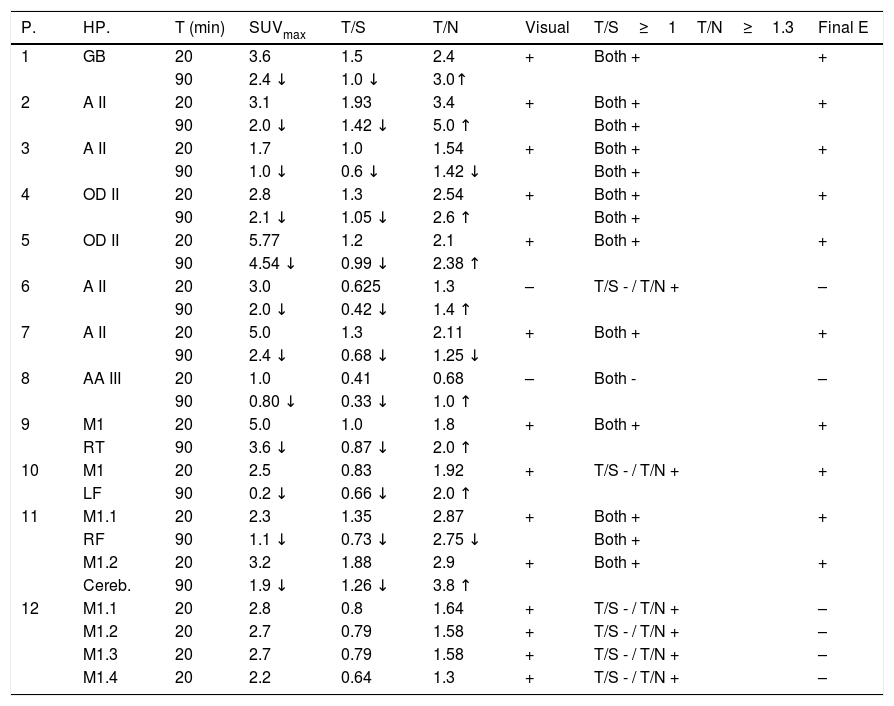To evaluate the utility of brain 18F-DOPA PET/CT in the differential diagnosis of brain lesions with inconclusive MRI.
Material and methodsTwelve patients were studied, with a total of 16 lesions, without definitive diagnosis after brain MRI. A double acquisition PET/CT brain scan was acquired at 20 and 90min. Visual and semiquantitative assessment was performed with SUVmax calculation of the lesions and calculation of the T/S Ratio (tumor/contralateral striatum) and T/N Ratio (contralateral healthy tumor/parenchyma) for each time.
ResultsBased on the visual assessment scale and using T/S ratio ≥1 and T/N ratio ≥1.3 to determine malignancy, the values of sensitivity (S), specificity (E) and positive predictive value (PPV) were: visual assessment (S 100%, E 33.3%, VPP 71.4%), T/S Ratio (S 90%, E 100%, VPP 100%) and T/N Ratio (S 100%, E 16.6%, VPP 66.6 %). No lesion showed an increase in SUVmax in late acquisition. 18F-DOPA PET/CT modified treatment in 75% of the patients.
Conclusion18F-DOPA PET/CT is a useful tool in the study of brain lesions with inconclusive MRI. Late imaging (dual-point) has no added value in the final diagnosis. FDOPA has an impact on patient management modifying therapeutic behavior.
Valorar la utilidad de la 18F-DOPA PET/TC cerebral en el diagnóstico diferencial de lesiones cerebrales con RM no concluyente.
Material y métodosSe estudiaron 12 pacientes, con un total de 16 lesiones, sin diagnóstico definitivo tras RM cerebral. Se adquirió estudio 18F-DOPA PET/TC cerebral con doble adquisición a los 20 y 90minutos. Se realizó valoración visual y semicuantitativa con cálculo del SUVmax de las lesiones y cálculo del Ratio T/S (tumor/estriado contralateral) y Ratio T/N (tumor/parénquima sano contralateral) para cada uno de los tiempos.
ResultadosBasado en la escala de valoración visual y utilizando los ratios T/S≥1 y T/N≥1.3 para determinar la positividad de un estudio, los valores de sensibilidad (S), especificidad (E) y valor predictivo positivo (VPP) han sido los siguientes: valoración visual (S 100%, E 33.3%, VPP 71.4%), Ratio T/S (S 90%, E 100%, VPP 100%) y Ratio T/N (S 100 %, E 16.6%, VPP 66.6%). Ninguna lesión mostró un aumento del SUVmax en la adquisición tardía. La 18F- DOPA PET/TC modificó el comportamiento terapéutico en el 75% de los pacientes.
ConclusiónLa 18F-DOPA PET/TC es una herramienta útil para diferenciar la etiología de lesiones cerebrales con RM no concluyente. La imagen tardía (dual point) no aporta un valor añadido al diagnóstico final. Los estudios con FDOPA tienen impacto en el manejo del paciente modificando la conducta terapéutica.
Artículo

Revista Española de Medicina Nuclear e Imagen Molecular (English Edition)
Comprando el artículo el PDF del mismo podrá ser descargado
Precio 19,34 €
Comprar ahora









